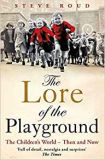The Lore of the Playground: The Children's World - Then and Now by Steve Roud
| The Lore of the Playground: The Children's World - Then and Now by Steve Roud | |
|
| |
| Category: Home and Family | |
| Reviewer: Trish Simpson-Davis | |
| Summary: A detailed and longitudinal view of games and rhymes in the playground. Meticulously researched but leaving some interesting questions unanswered. | |
| Buy? Yes | Borrow? Yes |
| Pages: 480 | Date: September 2011 |
| Publisher: Arrow | |
| External links: Author's website | |
| ISBN: 978-0099505273 | |
| Video:
| |
Like many reviewers of the hardback edition, I thoroughy enjoyed reading this book, a nostalgic excursion into my own childhood games and rhymes. It's quite fun to identify the regional context of childhood lore. It cleared up for me, as a South-East Londoner, the exact nature of a hitherto mysterious game called tag. If you have already delved into the classic The Lore and Language of Schoolchildren by Iona and Peter Opie (1959), you might find this book adds little for a general readership. For the specialist, I'm sure this book will take its rightful place in the scholarly literature on childhood culture.
There is a lot of stuff in this book comparing traditional playground activities such as clapping, skipping rhymes and games of tag with their earlier manifestations. As Steve Roud says, adults have always bemoaned the demise of childhood games, but photographs at three different time points prove the point that costumes change, but games prove amazingly constant. Interestingly, adults today often formalise the games, as in the hopscotch markings on school playgrounds, put there recently to encourage more physical activity. I was aware of the plethora of books servicing teachers' search for novelty in PE lessons at nil cost. It's nice to know that they are also conserving traditional games at the same time as encouraging physical activity.
I was interested that the singing games I remembered from Brownie days, like One elephant went out to play and In and out the dusky bluebells were again traditional games rescued from extinction by adults - and oh, how I loved them! Steve Roud makes the point that they were originally played by much older age groups, so that all that chasing, kissing and patting had a more sexual intention than nowadays.
He's right that modern children grow out of traditional rhymes more quickly. When I sang nursery rhymes to encourage various activities in my toddler swimming classes, lots of mums would look at me askance, and sometimes even get as far as saying that little Ermintrude or Horace was far too sophisticated at eighteen months for such babyish stuff. I suppose the subject matter is completely irrelevant and outdated (unless you want a child to pop out of the water like a weasel or fall in with a big splash like Humpty Dumpty, that is) but having a common bank of material on which the teacher can draw makes for a great session, whether its swimming, Baby Sensory, a nursery class, toddler group or whatever. Children's telly and their accompanying CD's have conserved so much material otherwise lost and promoted traditional songs to the widest possible audience. The author didn't really research that angle in any detail.
Some playthings have died out completely due to the changes in children's daily schedules: iron and wooden hoops, for example. Reportedly great toys, maybe they wouldn't be so great to bowl along today's busy roads. I wanted to know about crazes through the ages - the author referred to some, but I don't think there was a systematic sweep through this fascinating area.
And there's so much more to children's play than that. I really wanted a history of imaginative play ... now there's a topic to get your teeth into. I thought the treatment of modern lore left an awful lot out. The question I wanted answering was, how do children spend their time when they are playing (OK, so cut it down to the playground at school if you must) and how has that changed over the years?
So if you are asking me as an educator about this book, I'll give it five stars for a meticulously researched project which took me back to my own childhood. But for general readers, it’s a four. I feel it's too detailed and narrow in scope: to be truly informative, I'd like the author to have overviewed a wider area. My thanks to the publishers for sending this book.
Suggestions for further reading
Supposing you have a general interest in children's affairs, English Heritage have a similar title: The Games We Played by Susan Kelleher. I found Vyvyen Brendon's Prep School Children quite fascinating and on a more cynical note, Eric Clark's The Real Toy Story.
Please share on: ![]() Facebook,
Facebook, ![]() Twitter and
Twitter and
![]() Instagram
Instagram
![]() You can read more book reviews or buy The Lore of the Playground: The Children's World - Then and Now by Steve Roud at Amazon.co.uk Amazon currently charges £2.99 for standard delivery for orders under £20, over which delivery is free.
You can read more book reviews or buy The Lore of the Playground: The Children's World - Then and Now by Steve Roud at Amazon.co.uk Amazon currently charges £2.99 for standard delivery for orders under £20, over which delivery is free.
![]() You can read more book reviews or buy The Lore of the Playground: The Children's World - Then and Now by Steve Roud at Amazon.com.
You can read more book reviews or buy The Lore of the Playground: The Children's World - Then and Now by Steve Roud at Amazon.com.
Comments
Like to comment on this review?
Just send us an email and we'll put the best up on the site.


